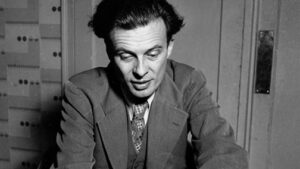 Aldous Huxley was born on this day in 1894 in Godalming, Surrey, England. Huxley was an English writer and philosopher. He wrote close to fifty books—both novels and non-fiction works—as well as wide-ranging essays, narratives, and poems. He was nominated for the Nobel Prize in Literature seven times and was elected Companion of Literature by the Royal Society of Literature in 1962.
Aldous Huxley was born on this day in 1894 in Godalming, Surrey, England. Huxley was an English writer and philosopher. He wrote close to fifty books—both novels and non-fiction works—as well as wide-ranging essays, narratives, and poems. He was nominated for the Nobel Prize in Literature seven times and was elected Companion of Literature by the Royal Society of Literature in 1962.
In his most famous novel Brave New World (1932), Huxley presented his vision of dystopia. Set mainly in a futuristic World State whose citizens are environmentally engineered into an intelligence-based social hierarchy. Brave New World shares a vision of scientific advancements and combines them into a dystopian society, challenged by the story’s protagonist.
In this lesson plan, students are introduced to the definition and characteristics of a dystopian work by watching video clips from The Matrix and other dystopian films. They first explore the definition and characteristics of utopian and dystopian societies, and then compare and contrast the two using a Venn diagram online tool. Next, they identify the protagonist in clips from The Matrix and then discuss how the clips extend and confirm their understanding of a dystopia. Students then view additional film clips and identify which characteristics of a dystopian society the clip is intended to portray. Finally, they explore how they can apply their knowledge about dystopias to future readings.
After reading or viewing a text like Brave New World, students are introduced to propaganda techniques and then identify examples in the text. Students discuss these examples, and then explore the use of propaganda in popular culture by looking at examples in the media. Students identify examples of propaganda techniques used in clips of online political advertisements and explain how the techniques are used to persuade voters. Next, students explore the similarities of the propaganda techniques used in the literary text and in the online political ads to explain the commentary the text is making about contemporary society. Finally, students write a persuasive essay in support of a given statement.
In this lesson plan, students first complete a survey to establish their beliefs about technology before using a literary elements map to explore the role of a fictional technology in a novel such as 1984, Brave New World, Fahrenheit 451, REM World, or Feed. Next, students discuss and debate what they believe the story’s author is saying about technology. By exploring the fictional technology, students are urged to think more deeply about their own beliefs and to pay attention to the ways that technology is described and used. This lesson plan can also be completed with short stories, video games, films, and other fictional resources that examine issues related to science and technology and their possible effects on society.
Does Brave New World, published in 1932, still resonate today? Read more in this letter from a student to Aldous Huxley to find that answer!
Curious about the NCTE and Library of Congress connection? Through a grant announced recently by NCTE Executive Director Emily Kirkpatrick, NCTE is engaged in new ongoing work with the Library of Congress, and “will connect the ELA community with the Library of Congress to expand the use of primary sources in teaching.” Stay tuned for more throughout the year!
It is the policy of NCTE in all publications, including the Literacy & NCTE blog, to provide a forum for the open discussion of ideas concerning the content and the teaching of English and the language arts. Publicity accorded to any particular point of view does not imply endorsement by the Executive Committee, the Board of Directors, or the membership at large, except in announcements of policy, where such endorsement is clearly specified.

